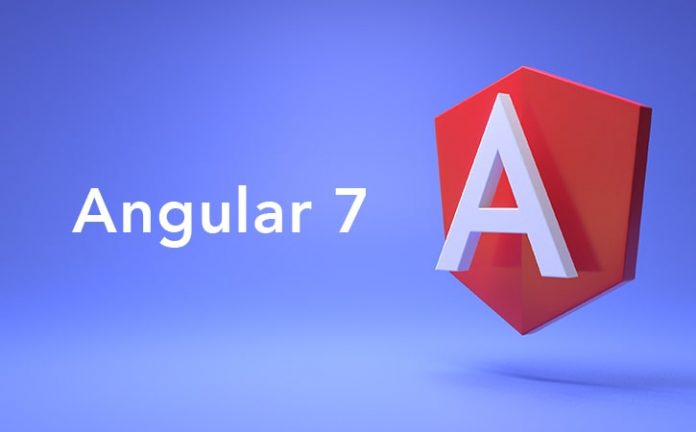Angular 7 Interview Questions – Most Asked Interview Question
Angular 7 interview questions Set 1
#1 What is Angular 7? How is it different from AngularJS?
Angular7 is the latest and recent version of Angular. AngularJS was the first version of Angular which is also known as Angular 1.0.
Angular7 is the complete rewrite of the Angular1.0. It supports two-way data binding, and some other features like ng update, ng add, Angular Elements, Angular Material + CDK Components, Angular Material Starter Components, CLI Workspaces, Library Support, Tree Shakable Providers, Animations Performance Improvements, and RxJS v6, etc.
#2 What are the Applications of Angular 7
- Google Supported Community – Google actively supports Angular and its development. Angular is used in various Google Apps.
- POJO based development – Angular heavily used Plain Old JavaScript Object and it helps in learning Angular in an easier way.
- Declarative User Interface – Angular uses HTML as a view language and extends its functionality. It helps in handling UI vs code differentiation and UI is loosely coupled with code.
- Typescript – Typescript is a superset of javascript and is easy to debug. It is highly secure and is object-oriented.
- Modular Structure – Angular development is highly modular, is component-based and is highly maintainable.
- Multi-platform support – Angular code works well on all platforms without much change in code.
#3 What are pipes? Give me an example.
A pipe takes in data as input and transforms it into the desired output. You can chain pipes together in potentially useful combinations. You can write your own custom pipes. Angular comes with a stock of pipes such as DatePipe, UpperCasePipe, LowerCasePipe, CurrencyPipe, and PercentPipe.
Consider:
<p>The
hero's birthday is {{ birthday | date }}</p>
A selector property is not required, as you can also use your components in a route.
#4 What are the key components of Angular?
Key components of Angular:
- Components: Components are the basic building blocks of angular application and used to control HTML views.
- Modules: Modules are the set of angular basic building blocks like component, directives, services, etc. An application is divided into logical pieces and each piece of code is called “module” and used to perform a single task.
- Templates: Templates are used to represent the views of an Angular application.
- Services: It is used to create components that can be shared across the entire application.
- Metadata: This can be used to add more data to an Angular class.
#5 What are the components in Angular7?
Components are the basic building blocks of an Angular app formed like a tree structure. Components are a subset of directives but unlike directives, components always have a template and only one component can be instantiated per an element in a template.
import { Component } from '@angular/core';
@Component ({
selector: 'my-app',
template: ` <div>
<h1>{{title}}</h1>
<div>Learn Angular6 with examples</div>
</div> `,
})
export class AppComponent {
title: string = 'Welcome to Angular world';
}
#6 What is a module?
Modules are the logical boundaries in the application. An application is divided into separate modules to separate the functionalities of the application.
For example, app.module.ts root module declared with @NgModule decorator
import { NgModule } from '@angular/core';
import { BrowserModule } from '@angular/platform-browser';
import { AppComponent } from './app.component';
@NgModule ({
imports: [ BrowserModule ],
declarations: [ AppComponent ],
bootstrap: [ AppComponent ]
})
export class AppModule { }
Here, the NgModule decorator has three options:
- The import option is used to import other dependent modules. The BrowserModule is required by default for any web-based angular application.
- The declarations option is used to define components in the respective module.
- The bootstrap option tells Angular which Component to bootstrap in the application.
#7 What’s the difference between an Angular component and module?
Components control views (HTML). They also communicate with other components and services to bring functionality to your app.
Modules consist of one or more components. They do not control any HTML. Your modules declare which components can be used by components belonging to other modules, which classes will be injected by the dependency injector, and which component gets bootstrapped. Modules allow you to manage your components to bring modularity to your app.
#8 How can I select an element in a component template?
You can get a handle to the DOM element via ElementRef by injecting it into your component’s constructor:
constructor(myElement:
ElementRef) { ... }
#9 What is Redux and how does it relate to an Angular app?
Redux is a way to manage application state and improve the maintainability of asynchronicity in your application by providing a single source of truth for the application state, and unidirectional flow of data changes in the application. ngrx/store is one implementation of Redux principles.
Angular 7 interview questions Set 2
#10 How would you update Angular 6 to Angular 7?
You can update Angular 6 to Angular 7 by using the following command:
ng update @angular/cli @angular/core
#11 What is the UrlSegment Interface in Angular 7?
In Angular 7, the UrlSegment interface represents a single URL segment, constructor, properties, and methods like this:
class UrlSegment {
constructor(path: string, parameters: {...})
path: string
parameters: {...}
toString(): string
}
The UrlSegment is a part of a URL between the two slashes and it contains a path and matrix parameters associated with the segment.
#12 What are the new features added in Angular7?
Following is a list of new features added in Angular7:
- Angular7 displays an elegant look in the new update.
- It provides virtual scrolling by using the scrolling package.
- It facilitates you to use drag and drop property by using the @angular/cdk/drag-drop module.
- In Angular7, libraries make changes to itself automatically with the updated version of the Material Design.
- Angular7 provides better error handling for @Output if the property is not initialized.
- Angular7 provides added support for Node v10.
Some more Angular7 features are:
Angular Console: It is a downloadable console to start and run Angular projects on your local machine.
@angular/fire: It is the latest update on npm, and has its first stable release for Angular7.
NativeScript: It facilitates you to make a single project that builds for both web and installed mobile.
StackBlitz: StackBlitz 2.0 is now released and includes the Angular Language Service and more features like tabbed editing.
#13 What is Do Bootstrap (ng Do Bootstrap) In Angular 7?
The ng Do Bootstrap is a new life-cycle hook added in Angular 7 and Do Bootstrap is an interface.
Example
//ng Do Bootstrap - Life-Cycle Hook Interface
classApp Module implements Do Bootstrap {
ng Do Bootstrap(appRef: ApplicationRef) {
appRef.bootstrap(AppComponent);
}
}
#14 What are the Core Dependencies of Angular 7?
There are two types of core dependencies, RxJS and TypeScript.
•RxJS 6.3 – RxJS version 6.3 is used by Angular 7. It has no changes in the version from Angular 6
•TypeScript 3.1 – TypeScript version 3.1 is used by Angular 7. It is the upgrade from version 2.9 of Angular 6.
#15 What are the utility functions provided by RxJs?
The RxJS library also provides below utility functions for creating and working with observables.
- Converting existing code for async operations into observables
- Iterating through the values in a stream
- Mapping values to different types
- Filtering streams
- Composing multiple streams
#16 What is subscribing?
An Observable instance begins publishing values only when someone subscribes to it. So you need to subscribe by calling the subscribe() method of the instance, passing an observer object to receiving the notifications.
Let’s take an example of creating and subscribing to a simple observable, with an observer that logs the received message to the console.
Creates an observable sequence of 5 integers, starting from 1
const source = range(1, 5);
// Create observer object
const myObserver = {
next: x => console.log('Observer got a next value: ' + x),
error: err => console.error('Observer got an error: ' + err),
complete: () => console.log('Observer got a complete notification'), };
// Execute with the observer object and Prints out each item
myObservable.subscribe(myObserver);
// => Observer got a next value: 1
// => Observer got a next value: 2
// => Observer got a next value: 3
// => Observer got a next value: 4
// => Observer got a next value: 5
// => Observer got a complete notification
#17 What is the router outlet?
The RouterOutlet is a directive from the router library and it acts as a placeholder that marks the spot in the template where the router should display the components for that outlet. Router outlet is used as a component,
<router-outlet></router-outlet>
<!-- Routed components go here -->
#18 What is the UrlSegment Interface in Angular 7?
In Angular 7, the UrlSegment interface represents a single URL segment, constructor, properties, and methods like this:
class UrlSegment {
constructor(path: string, parameters: {...})
path: string
parameters: {...}
toString(): string
}
#19 What are the ways to control AOT compilation?
You can control your app compilation in two ways
- By providing template compiler options in the tsconfig.json file
- By configuring Angular metadata with decorators
#20 What is TestBed?
The Angular Test Bed (ATB) is a higher level Angular Only testing framework that allows us to easily test behaviors that depend on the Angular Framework.
We still write our tests in Jasmine and run using Karma but we now have a slightly easier way to create components, handle injection, test asynchronous behavior and interact with our application.
The TestBed creates a dynamically-constructed Angular test module that emulates an Angular @NgModule.
These were the Angular 7 interview questions Stay tuned to learn more.
Check it out Latest Jobs for Angular Developer: Click here
If You Want To Get More Daily Such Jobs Updates, Career Advice Then Join the Telegram Group From Given Link And Never Miss Update.
Join Telegram Group of Daily Jobs Updates for 2010-2021 Batch: Click Here
Why You’re Not Getting Response From Recruiter?: Click here
How To Get a Job Easily: Professional Advice For Job Seekers: Click here
Cognizant Latest News: Up To 20K+ Employees Will Be Hired: Click here
COVID-19 Live Tracker India & Coronavirus Live Update: Click here
Why Remove China Apps took down from Play store?: Click here
Feel Like Demotivated? Check Out our Motivation For You: Click here
List of Best Sites To Watch Free Movies Online in 2020: Click here
5 Proven Tips For How To Look Beautiful and Attractive: Click here























